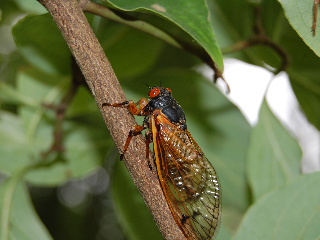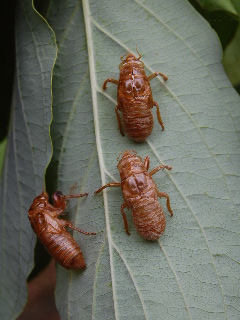
Growing up in a rural area of east Tennessee, one of the most familiar and pleasing sounds of summer was the afternoon and evening song of the cicadas. The slow, pulsing rhythm of their call seemed to fit right in with the lazy, liquid heat of the season. (See our article
Summer Evening Song)
Cicadas are insects of the order Hemiptera, characterized by piercing, sucking mouthparts that allow them to feed on the saps and juices of plants.
The different species of cicadas have varying life cycles that range in length from 2 years to 13 or 17 years in some cases. The greater portion of the cicada’s life is spent underground in the nymph stage.
When the nymphs emerge from the underground darkness into the bright sunny warmth of the summer sunshine, they molt into winged adults that have but one purpose in mind—to mate and produce offspring that then head immediately back down into that same subterranean darkness from which they came. See our GardenVoice YouTube video at:
Return Of The Cicadas
It is the winged and flying adult stage that we are most familiar with. This is the period of their life when the adult males are actively singing to the females about the possibility of one of Nature’s notoriously brief encounters that will result in the continuation of the great tradition of cicada choirs that will croon to the coming generations.
The song of the cicada is produced by membranes on the insect’s body rather than by vibrations of its wings or by rubbing its feet or legs together.
When the adult cicadas have mated, the female deposits her eggs into small slits that she cuts into the stems of trees and shrubs. The young cicadas hatch, drop from the stems onto the ground, and burrow into the soil where they will feed on the sap of tree roots until their time comes to seek the sun again.
Often, the most desirable vegetative sites for depositing the eggs seems to be the tender new shoots of young shade trees—maples and dogwoods appear to be especially vulnerable to egg-laying females.

Although the adult cicadas are not technically harmful to people, they can be a bit of a nuisance.
The noise generated by lawnmowers or other outdoor power equipment such as blowers or trimmers sometimes attracts the cicadas that mistake the mechanical sounds for the vibrations of amorous fellow cicadas. The result can be that the user of the equipment mistakenly thinks he or she is being swarmed or attacked by the insects.
Cicadas have tiny barbs at the ends of their legs that allow them to cling to trees, shrubs, or any other objects they may so desire (often vertical brick walls). When a cicada lands on bare skin, the insect’s tiny barbs may cause the human landee (you!) to think you are being bitten or stung by the winged invader. Such is not the case—cicadas have no stingers, and their only desires are to feed on the juices of plants, mate, and send their babies underground while ma and pa cicada head for glory in insect heaven.
One longer-range problem produced by the egg-laying cicadas is that there can be some damage to those tender plant shoots where the eggs are deposited--damage that may show up in the weeks and months to come as dead and dying ends of tree limbs. If you have a newly-planted tree, you might want to protect it with cheesecloth or some form of dense webbing to keep the adults away until they have done their thing.
Otherwise, just try to take comfort in the fact that the cicadas are not there to hurt you. Just relax and enjoy their free summer concert!
 Growing up in a rural area of east Tennessee, one of the most familiar and pleasing sounds of summer was the afternoon and evening song of the cicadas. The slow, pulsing rhythm of their call seemed to fit right in with the lazy, liquid heat of the season. (See our article
Growing up in a rural area of east Tennessee, one of the most familiar and pleasing sounds of summer was the afternoon and evening song of the cicadas. The slow, pulsing rhythm of their call seemed to fit right in with the lazy, liquid heat of the season. (See our article  Although the adult cicadas are not technically harmful to people, they can be a bit of a nuisance.
Although the adult cicadas are not technically harmful to people, they can be a bit of a nuisance.